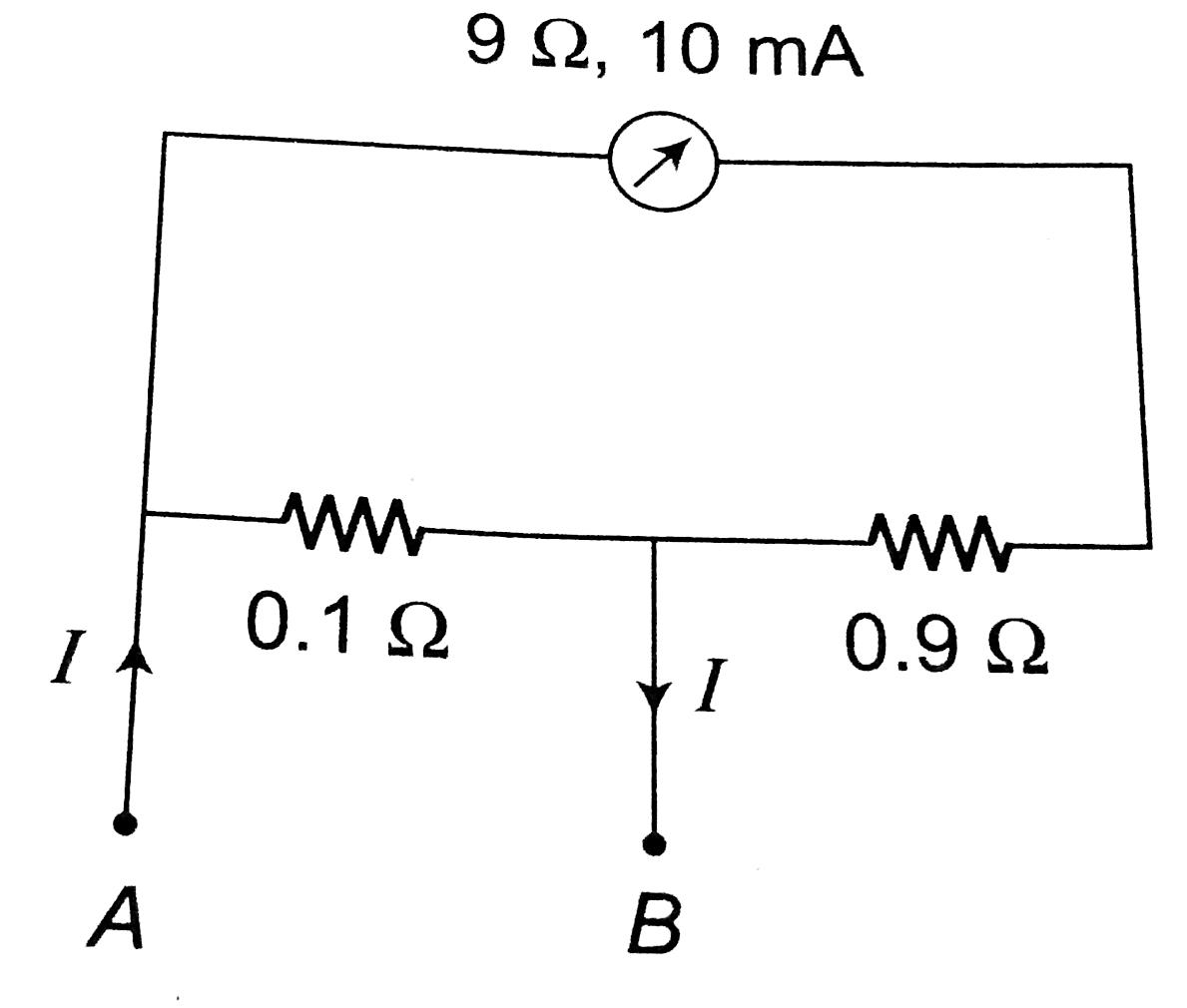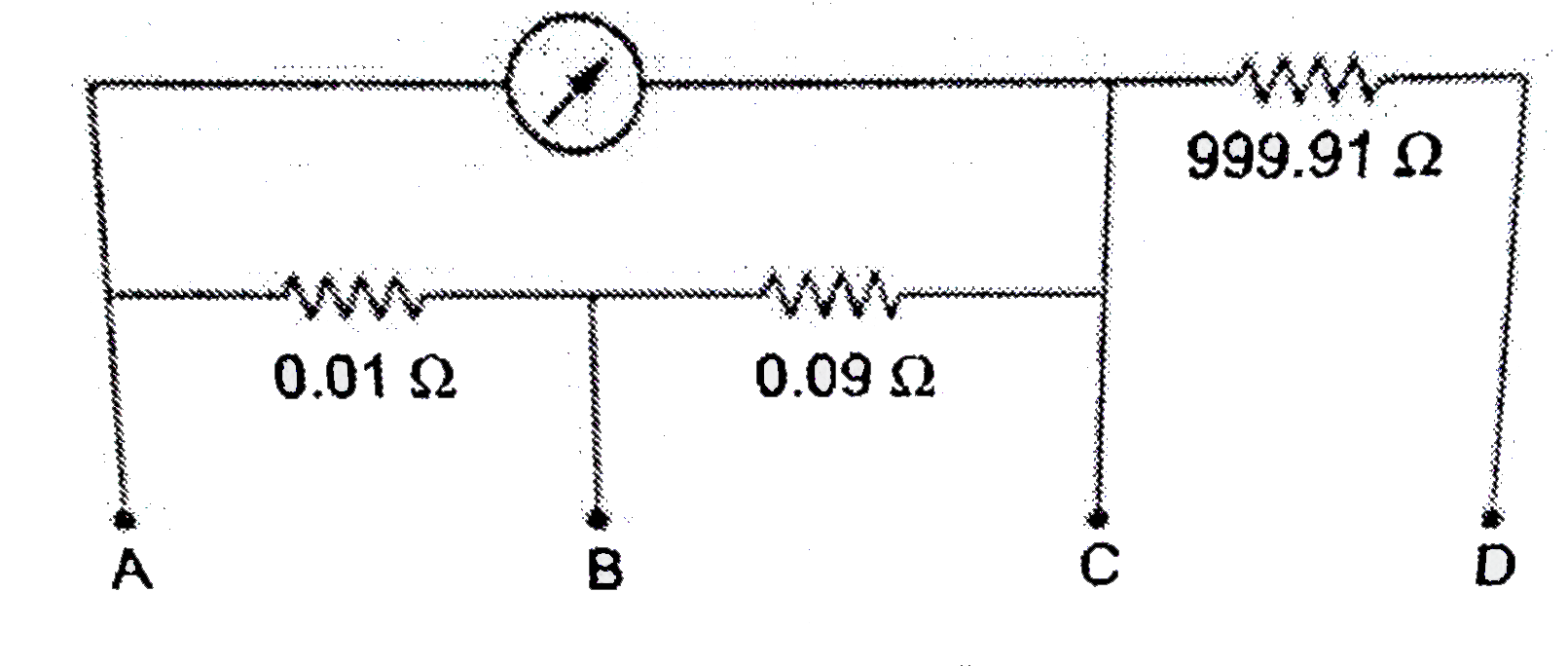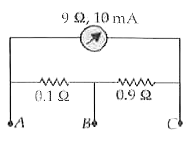A milliammeter of range 10mA and resistance 9Ω is joined in a circuit as shown. The metre gives full-scale deflection for curretn I when A and B are used as its terminals, i.e., current enters at A and leaves at B (C is left isolated). The value if I is

100 mA
900 mA
1A
1.1A
The correct Answer is:C

(I−10×10−3)×0.1=(9+0.9)×10×10−3
I−10×10−3=990×10−3
I=1000×10−3=1A.
Topper's Solved these Questions
Similar Questions
A galvanometer gives full scale deflection with current Ig. Can it be converted into an ammeter of range I<Ig?
View SolutionElectrical multimeters, or multitesters, are widely used by technicians when working with electrical and electronic circuits. In this instrument, a single milliammeter connected through different resistances is used to measure currents, potential differences and resistance over different ranges.
Current always enters the multimeter at the same terminal, A, and then passes through the milliammeter as well as through other resistances, placed in series with or parallel to it. The choice of the terminal at which current leaves the instrument decides its role (ammeter, voltemeter, etc.) and its range (maximum current or voltage which it can measure).
The milliammeter shown in the circuit has a coil (or internal ) resistance of 0.9ω and gives the full-scale deflection for a current of 10mA.

If A and B are used as the terminals of the multimeter, i.e., current enters at A and leaves at B, it will function as an ammeter of rangeView Solution
Knowledge Check
- Question 1 - Select One
A milliammeter of range 10 mA and resistance 9 Ω is joined in a circuit as shown in the figure. The metre gives full scale deflection for current / when A and B are used as its terminals, i.e., current enters at A and leaves at BC is left isolated). The value of /is
 A100mAB900MaC1AD1.1A
A100mAB900MaC1AD1.1A - Question 2 - Select One
A milli- ammeter of range 10mA and resistance 9Ω are joined in a circuit as shown in the fig. The meter gives full scale deflection, when current in the main circuit is I, and A and D are used as terminals. The value of I is
 A1.09AB10.9 ACzeroD0.109 A
A1.09AB10.9 ACzeroD0.109 A - Question 3 - Select One
A milli-ammeter of range 10mA and resistance 9Ω is joined in a circuit as shown in the figure. The meter gives full scale deflection, when circuit in the main circuit is 'I' and A and D are used as terminals. The value of I is
 A1.09AB10.9ACzero.D0.109A
A1.09AB10.9ACzero.D0.109A
Electrical multimeters, or multitesters, are widely used by technicians when working with electrical and electronic circuits. In this instrument, a single milliammeter connected through different resistances is used to measure currents, potential differences and resistance over different ranges.
Current always enters the multimeter at the same terminal, A, and then passes through the milliammeter as well as through other resistances, placed in series with or parallel to it. The choice of the terminal at which current leaves the instrument decides its role (ammeter, voltemeter, etc.) and its range (maximum current or voltage which it can measure).
The milliammeter shown in the circuit has a coil (or internal ) resistance of 0.9ω and gives the full-scale deflection for a current of 10mA.

If A and C are used as the terminals of the multimeter, i.e., current enters at A and leaves at C, it will function as an ammeter of rangeView SolutionElectrical multimeters, or multitesters, are widely used by technicians when working with electrical and electronic circuits. In this instrument, a single milliammeter connected through different resistances is used to measure currents, potential differences and resistance over different ranges.
Current always enters the multimeter at the same terminal, A, and then passes through the milliammeter as well as through other resistances, placed in series with or parallel to it. The choice of the terminal at which current leaves the instrument decides its role (ammeter, voltemeter, etc.) and its range (maximum current or voltage which it can measure).
The milliammeter shown in the circuit has a coil (or internal ) resistance of 0.9ω and gives the full-scale deflection for a current of 10mA.

If A and D are used as the terminals of the multimeter , i.e., current eneters at A and leaves at D, it will function as a voltmeter of which range?View SolutionAn ammeter has a resistance of 100ΩA potential difference of 50 m V between its terminals gives full scale deflection. How will you convert it into an ammeter of range 5A ?
View SolutionAn ammeter gives full scale deflection when current of 1.0 A is passed in it. To convert it into 10 A range ammeter, the ratio of its resistance and the shunt resistance will be
View SolutionA galvanometer coil has a resistance of 15Ω and the metre shows full scale deflection for a current of 4 mA. To convert the meter into a voltmeter of range 0 to 18 V, the required resistance is
View Solution
